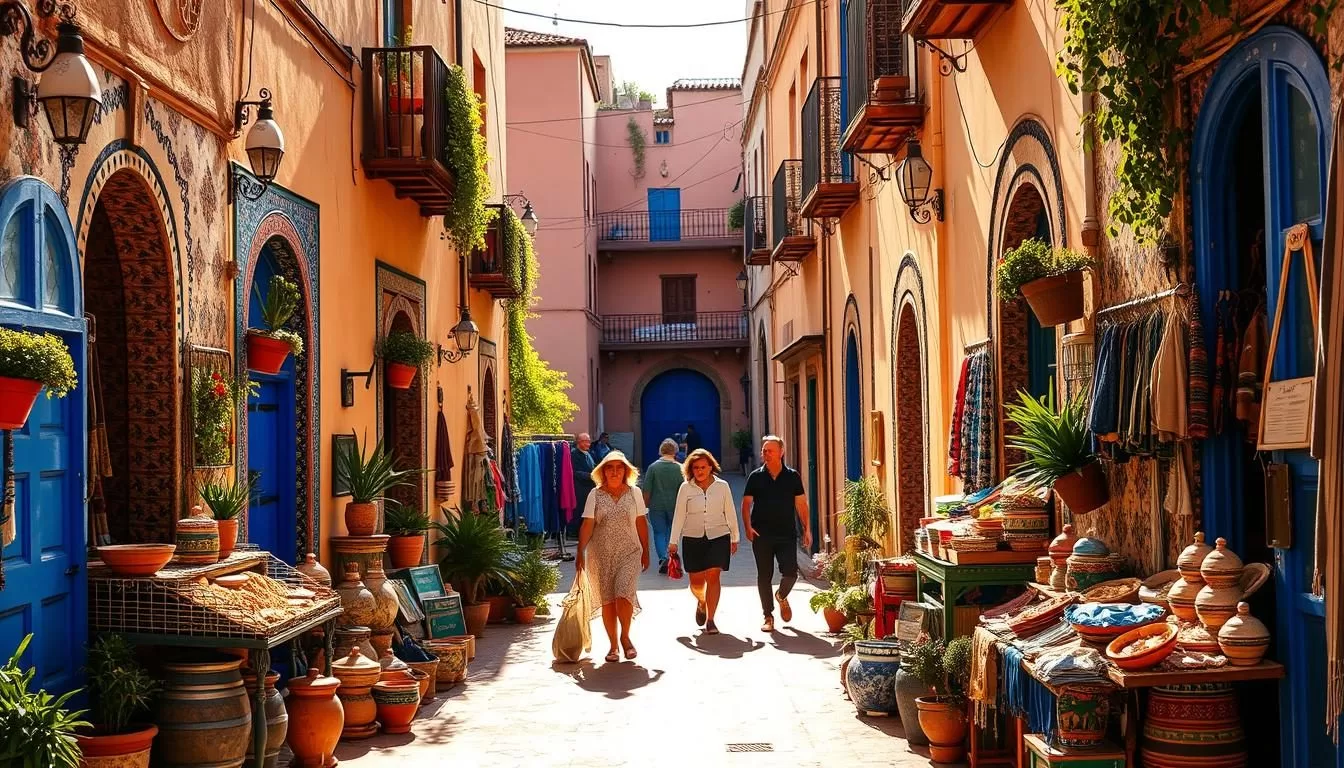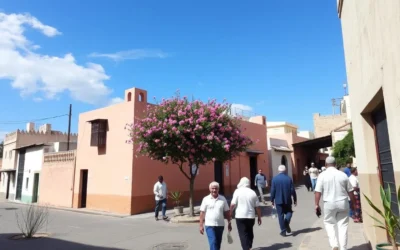✓ Accommodations✓ Flights✓ Rental Cars✓ Tours & Activities
Planning a trip to Morocco can be a thrilling experience, but timing is everything. With its diverse landscapes and climates, there’s no bad time to visit, but some periods are more ideal than others.
The country’s shoulder seasons, April-May and September-November, offer the most comfortable temperatures and smaller crowds, making them the best time to explore imperial cities, trek the Atlas Mountains, or relax on coastal beaches.
Understanding Morocco’s climate patterns will help you plan the perfect trip aligned with your travel preferences and activities, ensuring an unforgettable adventure in this North African gem.
Understanding Morocco’s Diverse Climate
Morocco’s geographical diversity gives rise to a wide range of climates, making it essential to consider regional variations when planning a trip. The country’s climate is influenced by its location in the Northern Hemisphere, with distinct seasonal patterns.
Northern Hemisphere Seasons
Morocco follows the same basic seasonal pattern as other Northern Hemisphere countries. Winter lasts from December to February, while summer spans from June to August. During the peak summer months, the weather can become uncomfortably hot, especially in inland cities like Marrakesh and Fez.
Regional Climate Variations
The country’s diverse geography creates remarkable regional climate variations. Coastal destinations like Tangier, Rabat, and Essaouira benefit from the moderating influence of the ocean, keeping temperatures relatively mild. In contrast, interior cities experience more extreme temperature fluctuations between day and night, particularly during the summer.
| Region | Summer Temperatures | Winter Temperatures |
|---|---|---|
| Coastal | Mild | Mild |
| Inland | Very Hot | Cool |
| Mountainous | Mild | Cold |
Temperature Extremes to Consider
When planning your trip, it’s crucial to consider temperature extremes. Summer highs can reach 115°F (46°C) in interior cities and the desert, while winter nights in the mountains can drop below freezing. Understanding these variations will help you time your visit to each area of Morocco for optimal weather conditions.
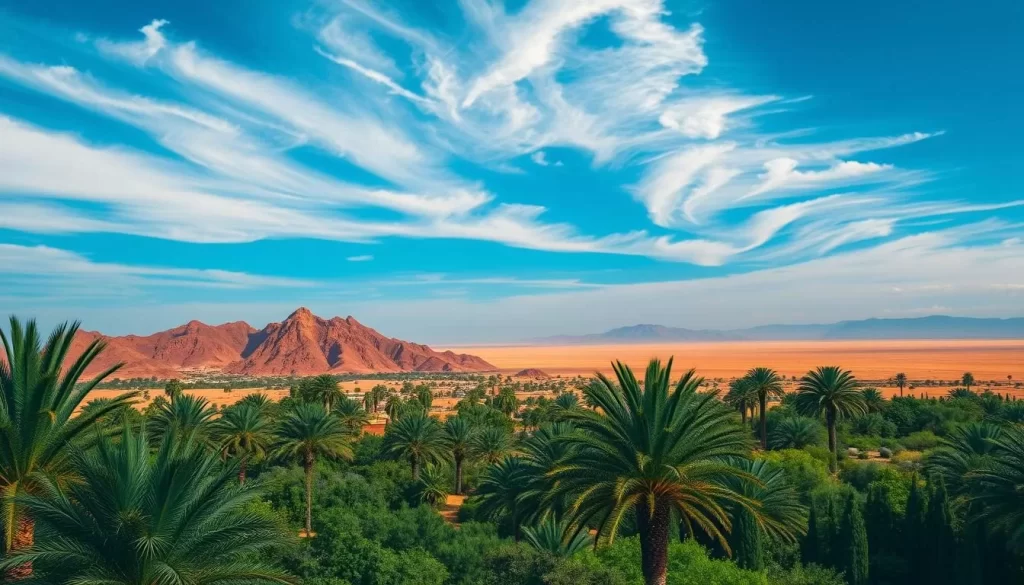
Spring in Morocco: A Blossoming Experience
Spring is a magical time in Morocco, transforming the country into a haven of wildflowers, greenery, and adventure. As the winter chill dissipates, the landscape awakens with vibrant colors and pleasant temperatures, making it an ideal time for travelers to explore.
March to May Weather Overview
During the spring months (March to May), Morocco experiences warm and dry weather, with daytime temperatures ranging from 65°F to 75°F (18°C to 24°C) in most regions. This creates perfect conditions for outdoor activities and exploration.
Spring Advantages: Wildflowers and Greenery
The spring season brings numerous advantages for travelers. The Atlas Mountains become particularly picturesque as wildflowers bloom, carpeting the valleys and lower slopes. Northern Morocco also transforms with lush greenery, making cities like Fez and Chefchaouen even more photogenic.
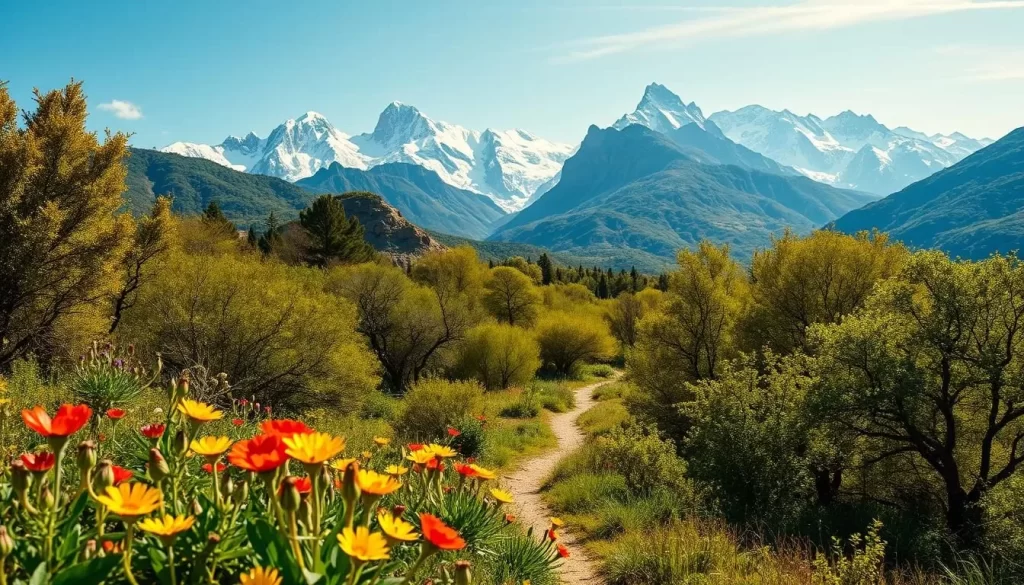
Perfect Time for Atlas Mountains Hiking
Spring is considered the perfect time for hiking in the Atlas Mountains, with clear trails, comfortable temperatures, and breathtaking panoramic views. The snow-capped peaks against the green landscapes create a stunning scenery, ideal for hikers and photographers. Some of the key benefits of hiking in the Atlas Mountains during spring include:
- Mild temperatures and clear trails
- Breathtaking scenery with wildflowers in bloom
- Lush greenery in the valleys and lower slopes
With its pleasant weather, vibrant landscapes, and exciting outdoor activities, spring is undoubtedly one of the best times to visit Morocco. Whether you’re looking for adventure, cultural experiences, or simply a relaxing trip, Morocco in the spring has something to offer for every kind of traveler.
Summer in Morocco: Navigating the Heat
The summer season in Morocco brings a unique blend of challenges and opportunities for travelers. While the heat can be intense, especially in inland cities, there are strategies to make the most of your visit.
June to August Temperature Patterns
Summer in Morocco is characterized by high temperatures, often exceeding 100°F (38°C) in cities like Marrakech and Fez. The heat is particularly oppressive in the southwest region. However, the coastal areas offer a cooler alternative, with temperatures typically 15-20 degrees lower than inland.
Coastal Retreats: Where to Escape the Heat
Destinations like Essaouira, Tangier, and Agadir become popular retreats during the summer. The Atlantic coast offers pleasant beach weather and refreshing sea breezes, making it an ideal location for those seeking to escape the heat. You can enjoy various coastal activities, from swimming to water sports.
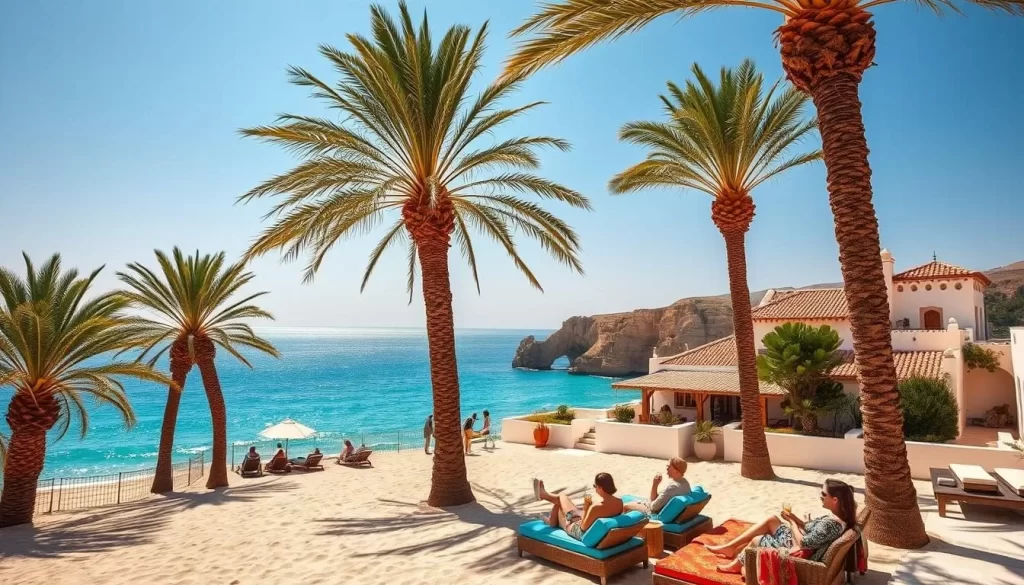
Budget Benefits of Summer Travel
Although summer is considered low season for international tourism in Morocco, it presents budget-friendly opportunities. Many riads and hotels offer significant discounts to attract visitors. You can enjoy a more affordable stay in interior cities, making it an excellent time for budget travelers to explore Morocco.
Fall in Morocco: The Golden Season
With the arrival of fall, Morocco awakens from its summer slumber, presenting a great opportunity for travelers. The season brings a welcome change, offering ideal weather conditions across most regions.
September to November Climate Conditions
During the fall, temperatures range from 70°F to 85°F (21°C to 29°C), making it an ideal time to visit. September starts with summer-like warmth, while October and November bring increasingly mild conditions, perfect for exploring Morocco’s imperial cities.
Ideal Time for City Exploration
Fall is an excellent time to explore Morocco’s vibrant cities. You can wander through medinas, visit historical sites, and enjoy outdoor cafés in comfortable temperatures. The season offers a great experience, allowing you to appreciate the local culture without the discomfort of summer heat or winter chill.
Desert Adventures in Autumn
The Sahara Desert becomes accessible again in fall, with pleasant daytime temperatures and magical stargazing opportunities during cool desert nights. You can enjoy desert adventures, taking in the breathtaking landscapes and experiencing the unique culture of the desert communities.
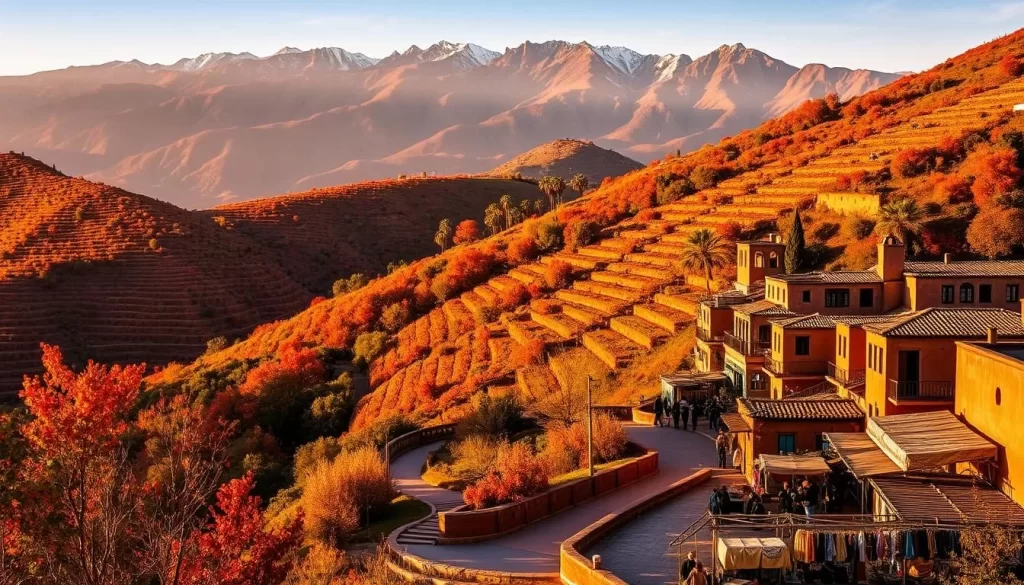
Winter in Morocco: Unexpected Delights
Discover the unexpected delights of Morocco during the winter season, a time of mild weather and exciting activities. You can enjoy a unique trip to Morocco, exploring its diverse landscapes and experiencing the local culture without the crowds.
December to February Weather Patterns
During the winter months, Morocco’s weather varies significantly across different regions. While the coastal areas enjoy mild temperatures, averaging 60°F to 70°F (15°C to 21°C) during the day, the nights can be quite cool. In contrast, the Atlas Mountains receive heavy snowfall, making it a great time for skiing and other winter sports.
Skiing in the Atlas Mountains
The Atlas Mountains transform into a winter wonderland, offering the unexpected opportunity to ski in Africa at resorts like Oukaïmeden, just a day trip from Marrakech. You can enjoy activities like skiing and snowboarding in a unique setting.
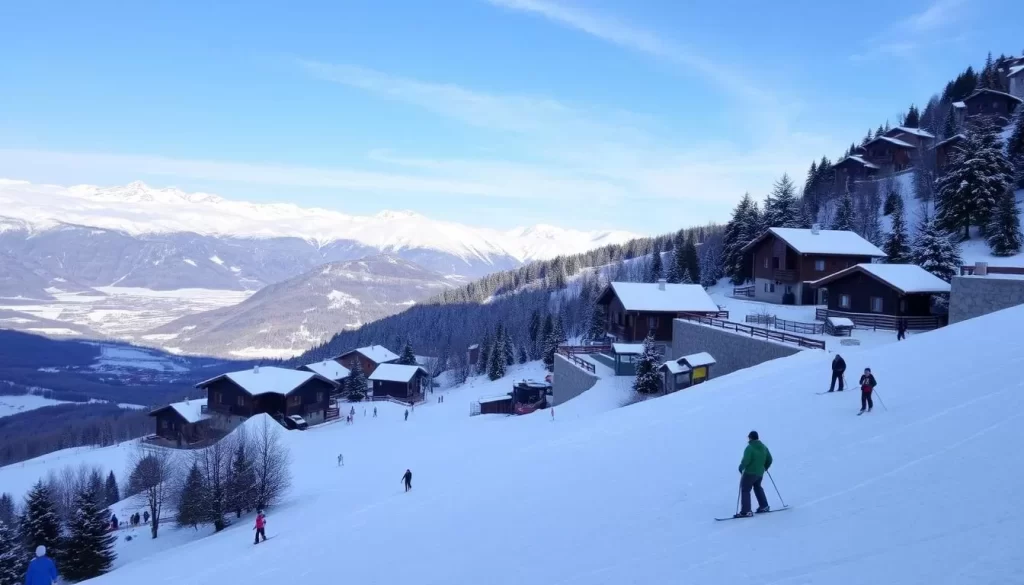
Off-Season Benefits and Considerations
Visiting Morocco in winter comes with several benefits, including lower tourist numbers and significant discounts on accommodations. However, you should be prepared for occasional rain in northern cities and potential mountain road closures after snowfall. Overall, it’s a great time to visit Morocco if you prefer fewer crowds and a more relaxed atmosphere.
Morocco: Best Months for a Weather-Savvy Trip by Region
The varied climate across Morocco’s regions means that travelers can find suitable weather conditions throughout the year by choosing the right destinations. This flexibility allows you to experience the best of Morocco, whether you’re interested in coastal retreats, urban explorations, or desert adventures.
Coastal Cities: Tangier, Rabat, and Essaouira
Coastal cities like Tangier, Rabat, and Essaouira enjoy moderate temperatures year-round. Summer (June-August) is perfect for beach activities with temperatures around 80°F (27°C), while winters are mild, with daytime temperatures around 65°F (18°C). The Atlantic coast is ideal for beachgoers from May to October.
Interior Cities: Marrakesh and Fez
Interior cities such as Marrakesh and Fez experience more extreme temperatures. Spring (March-May) and fall (September-November) are the best times to visit, with comfortable temperatures between 70-85°F (21-29°C), making these periods ideal for exploring the vibrant streets and historical sites.
Sahara Desert: Timing Your Adventure
For a Sahara Desert adventure, the best times are October-November and March-April. These periods offer comfortable daytime temperatures and cool nights, avoiding the extreme heat of summer and the cold of winter. Be aware that April can bring sandstorms due to the Sirocco wind.

Planning Around Morocco’s Festivals and Events
When planning your trip to Morocco, consider timing it around one of the many exciting festivals and events that take place throughout the year. Morocco’s rich cultural heritage is showcased through various celebrations, offering a unique and enriching experience for travelers.
Cultural and Religious Celebrations
Morocco’s cultural calendar is filled with significant religious celebrations, including Ramadan and Eid al-Adha, which provide a fascinating insight into the country’s culture. These events may affect opening hours and service availability, so it’s essential to plan accordingly.
Music and Arts Festivals
Morocco is also renowned for its music and arts festivals, such as the Essaouira Gnaoua and World Music Festival and the Marrakesh Popular Arts Festival. These events celebrate the country’s rich cultural diversity, featuring a mix of traditional and modern performances.
By incorporating these festivals into your travel plans, you can significantly enhance your experience and gain a deeper understanding of Moroccan culture. However, be aware that popular events can attract large crowds and higher prices, so advance planning is recommended.
Conclusion: Your Perfect Moroccan Weather Window
Morocco is a year-round destination, but the best time for your visit depends on what you want to experience. For a balance of comfortable weather and manageable crowds, consider the shoulder seasons of April-May and September-November.
Your trip to Morocco can be tailored to your preferences, whether that’s enjoying the mountain landscapes in spring or exploring the desert in autumn. With proper planning, you can have a memorable experience, immersed in Morocco’s rich culture and diverse landscapes.
The above is subject to change.
Check back often to TRAVEL.COM for the latest travel tips and deals.
